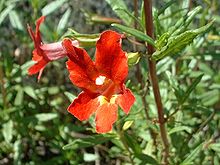- Mimulus aurantiacus
-
Mimulus aurantiacus 
Scientific classification Kingdom: Plantae (unranked): Angiosperms (unranked): Eudicots (unranked): Asterids Order: Lamiales Family: Phrymaceae Genus: Mimulus Species: M. aurantiacus Binomial name Mimulus aurantiacus
CurtisSynonyms Diplacus aurantiacus
Mimulus aurantiacus, the Sticky monkey-flower and Orange bush monkey-flower, is a flowering plant that grows in a subshrub form, native to southwestern North America from southwestern Oregon south through most of California. It is treated by some botanists in a separate genus from other Mimulus as Diplacus aurantiacus [1].
Contents
Description
Mimulus aurantiacus grows up to 1.2 meters-4 feet tall, has deep green sticky leaves 3 to 7 cm long and up to a centimeter broad and flowering stems that grow vertically.[2] The flowers are tubular at the base and about 2 centimeters long with five broad lobes; they occur in a variety of shades from white to red, the most common color being a light orange. They are honey plants pollinated by bees and hummingbirds.
It grows in many climates and will thrive in many types of soil, wet, dry, sandy, or rocky. It even grows in serpentine, a soil that most plants have difficulty thriving in because of its unique mineral composition.
Mimulus aurantiacus is a host plant for the checkerspot butterfly[3][4]. It is common to see checkerspot butterfly caterpillars on this plant.
Cultivation
Species and cultivars are used in water conserving, native plant, and habitat gardens.
Traditional Native American medical plant
The Miwok and Pomo Native Americans used its flowers and roots to treat a number of ailments, but was particularly useful for its antiseptic qualities as it expedited the healing of minor scrapes and burns.
Gallery
Notes
References
See also
 Media related to Mimulus aurantiacus at Wikimedia CommonsCategories:
Media related to Mimulus aurantiacus at Wikimedia CommonsCategories:- Phrymaceae
- Flora of Oregon
- Flora of California chaparral and woodlands
- Flora of the Sierra Nevada region (U.S.)
- Flora of the California desert regions
- Flora of the Sonoran Deserts
- Traditional Native American medical plants
- Garden plants of North America
- Drought-tolerant plants
- Bird food plants
- Hummingbirds
- Honey plants
Wikimedia Foundation. 2010.





